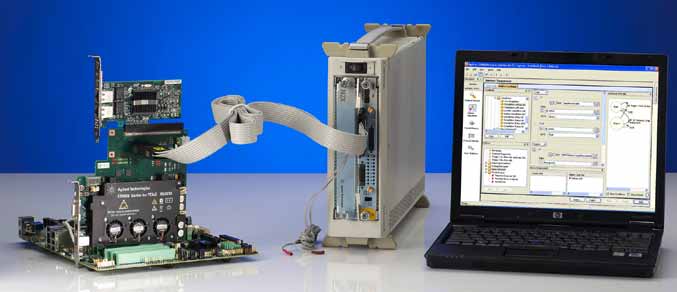Technology strides forward in leaps and bounds, enabling engineers to design and build even more sophisticated devices to improve productivity and performance. To ensure that the development process is successful, they need to be aware of the latest trends in protocol analysis, and that’s where this article comes in
Dilin Anand
 Electronics engineers working with the latest technology understand that for successful product development, they need to ensure that every required step has been taken and completed precisely the way it was designed.
Electronics engineers working with the latest technology understand that for successful product development, they need to ensure that every required step has been taken and completed precisely the way it was designed.
Protocol analysers are tools that optimise the engineers’ product development by passively monitoring data transmissions on the bus, thus allowing them to see any possible error in the communication between a host device and the product.
What’s fuelling their increased use
Even though most systems employ higher-level protocols, the simple fact is that any error can have a subtle effect on the overall device and system operating efficiencies. These seemingly minor errors can later on grow to cause competitive disadvantages for the product and the company which developed it.
Derek Fung, vice president- business, Total Phase, explains, “System designers will want to detect and correct all possible sources of low-level data errors so that their designs can operate with the highest level of system performance. They can optimise product development to its fullest capacity with a protocol analyser.”
Hundreds of new models of mobile devices have been released onto the market in the recent years. The rapid expansion of mobile phone technology, explosive growth in the number of mobile devices, and multiple standards for 2G, 3G and LTE also contribute to the growth of protocol analysis.
[stextbox id=”info”]Protocol analysis is a crucial part of mobile phone development. LTE is driving many new combinations of technology, all of which need to be tested thoroughly to ensure good customer experience —Stephen Hire, general manager, Aeroflex Asia[/stextbox]
Stephen Hire, general manager of Aeroflex Asia–India, adds, “Protocol analysis is a crucial part of mobile phone development. LTE is driving many new combinations of technology, all of which need to be tested thoroughly in order to ensure good customer experience. India’s and China’s adoption of the TD-LTE variant, and likely future deployment of LTE FDD, also put the world’s two largest markets by subscriber numbers onto a different track from mature cell-phone markets.”
Combined functionality
In developing countries like India, where the average revenue per user (ARPU) is far lower than in other countries, firms have to look at new techniques for cost reduction in order to keep a healthy margin for the company’s growth. One way to do this is to get more value from their instruments, which is done by getting single units that can perform various kinds of testing.
Stephen explains, “India and China also have much lower ARPUs forcing the manufacturers to look for cost savings in R&D. This requires lower-cost protocol analysis tools that may be described as ‘one box per engineer’ as they combine protocol, functional and RF testing in a single unit to maximise return on test investment. The larger number of combinations of LTE and legacy cellular technologies also increases the amount of testing, further reinforcing the need for flexible cost-effective tools.”
“Protocol analysers are largely used to verify protocol compliance. So compliance to various standards is an important feature desired by engineers. Also, protocol analysers that can show the data just as it appears in the specifications will be of great help to engineers working on those protocols. Debugging the protocol layer issues requires a different set of skills. While combining protocol, functional and RF testing might work for some protocols, it may not be efficient while debugging serial data solutions like PCIe and SAS,” shares Prabhanjana Rao, regional sales manager-India and SE Asia, ANZ, Teledyne LeCroy Corporation.
[stextbox id=”info”]User interfaces for these tools are becoming more and more user-friendly in the way they display decoded data, and hence protocol intricacies can now be dealt easily. It makes the task of test engineers fast and easy while maintaining the accuracy of testing —Siddharth Patel, Lead Engineer for Embedded Software, EATON India Engineering Centre[/stextbox]
[stextbox id=”info”]Oscilloscope-based protocol analysers have an inherent and unique capability of displaying protocol decoding correlated with the physical-layer analogue waveform. This correlation helps to trace back serial problems to their root cause in the analogue waveform —Sanchit Bhatia, Digital Applications Specialist, Agilent Technologies[/stextbox]
For the last few years, there has been an increase in the use of oscilloscopes for protocol decoding of serial buses as well. Initially, these were used for protocol decoding of low-speed buses like I2C and SPI, but the protocol applications of scopes have now expanded to incorporate many more buses like CAN, LIN, MIL-STD-1553, SATA, USB 2.0, USB 3.0, and all generations of PCI Express. Since oscilloscopes are already used for physical-layer debug of serial buses, the protocol analysis capability adds value by having a single instrument that provides the capabilities of an oscilloscope and protocol analyser.








